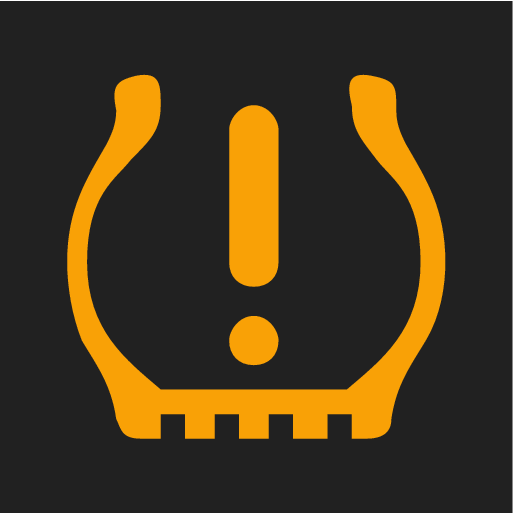Tyre pressure monitoring1
If the symbol first flashes for about one minute and then changes to a constant glow, it may indicate that the system cannot detect or warn of low tyre pressure as intended.
Tyre pressure monitoring uses detectors located on the air valve in each wheel. When the car is driven at approx. 30 km/h (20 mph), or faster, the system detects the tyre pressure. If the pressure is too low, a low tyre pressure indicator symbol in the driver display illuminates and a message is shown.
| Symbol | Specification |
|---|---|
 | The symbol illuminates in the event of low tyre pressure. In the event of a fault in the TPMS system, the symbol will first flash for approx. one minute and then illuminate with a constant glow. |
General information on the tire pressure monitoring system
Each tyre, including the spare tyre*, should be checked once a month. When checking, the tyre should be cold and have the air pressure recommended by the car manufacturer specified on the tyre pressure label or in the tyre pressure table. If the car has tyres of a different size than that recommended by the manufacturer, find out what the correct air pressure level is for these.
As an extra safety feature, the car is equipped with a tyre pressure monitoring system (TPMS), which shows when the air pressure of one or more tyres is too low. When the indicator symbol for low air pressure is lit, stop and check the tyres as soon as possible and inflate to the correct air pressure.
Driving on tyres with low tyre pressure may cause the tyre to overheat, which can cause a puncture. Low tyre pressure also reduces fuel efficiency and tyre service life, and can affect car handling and stopping ability. Note that TPMS does not replace regular tyre maintenance. It is the driver's responsibility to maintain correct tyre pressure, even if the limit for low tyre pressure has not been reached so that the indicator symbol illuminates.
The car is also equipped with a TPMS system fault indicator, which indicates when the system is not functioning correctly. The TPMS system fault indicator is combined with the indicator symbol for low tyre pressure. When the system detects a fault, the symbol in the driver display will flash for about one minute and then remain illuminated. This procedure will be repeated when the car is started until the fault has been rectified. When the symbol is illuminated, the system's ability to detect or warn of low tyre pressure may be affected.
A TPMS system fault can occur for several reasons, such as after changing to a spare tyre, or changing tyres or wheels that prevent TPMS from functioning properly.
Always check the indicator symbol for TPMS after changing one or more tyres to make sure the new tyre or wheel is functioning correctly with TPMS.
Both factory-fitted and optional wheels can be equipped with TPMS sensors in the valves. If the spare wheel or a wheel without a TPMS detector is used, an error message will be shown in the driver display after a few minutes of driving.
The system does not replace normal tyre maintenance.
Messages in the driver display
The following messages may be shown when the indicator symbol is illuminated:
- Tyre pressure system Service required.
- Tyre pressure system Temporarily unavailable
- Tyre pressure low as well as which tyre(s) is/are involved.
- Tyre needs air now, as well as which tyre(s) is/are involved.
If the system cannot determine which tyre has low pressure, a general warning is issued:
- Tyre pressure low Check tyres
- Tyre needs air now Check tyres
Recommendations
- TPMS sensors should be fitted to all of the car's wheels, winter wheels as well.
- Sensors should not be moved between different wheels.
- If a wheel has been changed, or if the TPMS sensor has been moved to another wheel then the valve seal and valve core must be replaced.
- When TPMS sensors are installed, the car should be switched off for at least 15 minutes otherwise an error message will be shown in the driver display.
- Always check the system after changing a wheel in order to ensure that replacement wheels work with the system. Make sure that new wheels have TPMS detectors to prevent system fault warnings.





